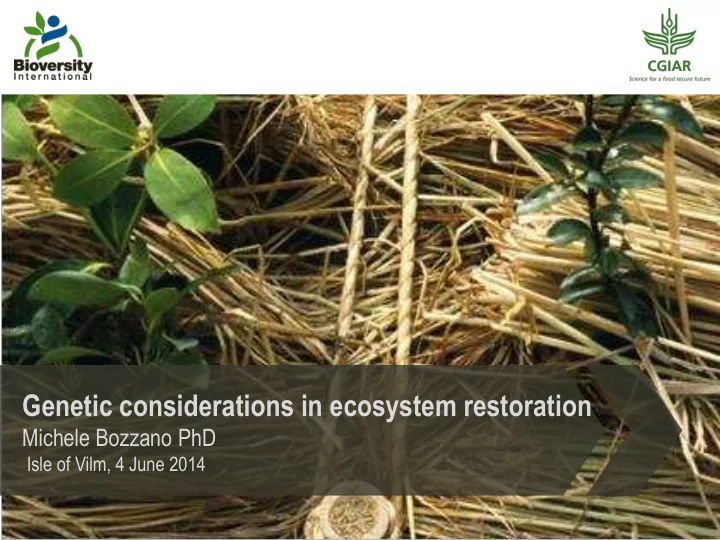

Genetic considerations in ecosystem restoration Michele Bozzano PhD Isle of Vilm, 4 June 2014
Experience in ecosystem restoration Thailand Malaysia Brazil Colombia
Why are genetic considerations important? • Increase long-term success of restoration • Restoring resilience • Conserve local populations and species • Provide ecosystem services
Why are genetic considerations important? Seed source forests must be • large to avoid inbreeding Origin of germplasm must • match site conditions to ensure adaptation Changing environment • 4
Thematic Study on genetic considerations in ecosystem restoration using native tree species
Thematic study • Commissioned by FAO for the first global report on the State of the World’s Forest Genetic Resources • Reviews on overarching issues: – Seed provenance, Propagation methods, Fragmentation, Gene flow, Hybridization, Collection of propagation material in the absence of genetic knowledge, Seed availability for restoration, Designing landscape mosaics • Description and case studies of restoration methods • Survey among restoration researchers and practitioners about common approaches • Analysis of genetic considerations in restoration practice • Recommendations for policy, practice and research 6
Case study locations 7
Limited attention to genetic considerations in restoration Few experimental studies on genetic considerations in restoration projects but most of those reveal: • Questionable matching of germplasm and site, e.g. mixing of seed from clearly distinct sources • Poor genetic quality of seed sources • Poor collection practices which had resulted in genetic bottlenecks, reflected as light seed and poor germination 8
Experiences among restoration practitioners A survey among 23 practitioners who have developed or advanced forest restoration methods • Only half of the restoration methods incorporated guidelines or recommendations for germplasm collection • “ it is very difficult to get people to collect seed from more than one tree ” • Lack of knowledge about and germplasm for native tree species was considered a main constraint to the wider application of the various restoration methods • More than half of the respondents indicated that the restoration methods do not consider effects of climate change . 9
Recommendations originated from the thematic study
Recommendations for research • Evaluate the impact of different restoration methods on the genetic diversity of restored tree populations. • Expand knowledge on native species, and identify ways to overcome constraints that limit their use in restoration. • Develop, make available and support the adoption of decision-support tools for: (i) collecting and propagating germplasm (ii) matching of species and provenances to restoration sites based on (current and future) site conditions, (iii) landscape-level planning in restoration projects. • Develop protocols to monitor and evaluate the genetic diversity of tree populations in restoration efforts as 11
Recommendations for restoration practice • Give priority to the use of native tree species • use FRM that is well matched to environmental conditions of the restoration site and represents a broad genetic base • aim to promote resilience by maximizing species and genetic diversity from sources that are similar to the site conditions • Plan for the sourcing of propagation material of desired species and associated information well before the intended planting • Consistently plan restoration efforts in the landscape context and seek to integrate them into the surrounding landscape matrix. 12
Recommendations for policy • Create an enabling national policy environment that fosters long-term , ecologically based forest management that explicitly favours the use of native species in ecosystem restoration and genetic conservation and provides adequate financial support. • Put in place supportive regulatory frameworks that guide the production and supply of FRM of native tree species and the use of adequately diverse material of appropriate origin in restoration efforts. • Broaden education and training curricula to promote understanding of the importance of using native species and genetically diverse and appropriate FRM 13
Thank you www.bioversityinternational.org
Recommend
More recommend